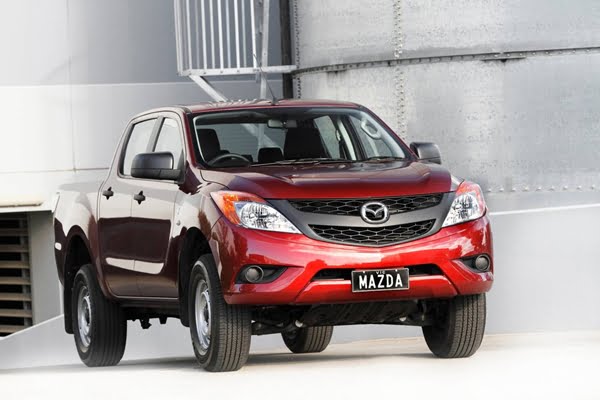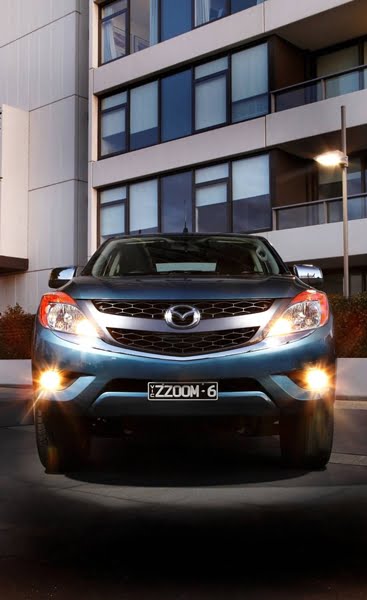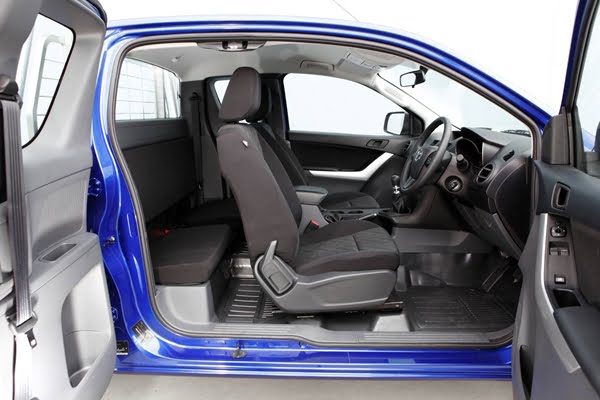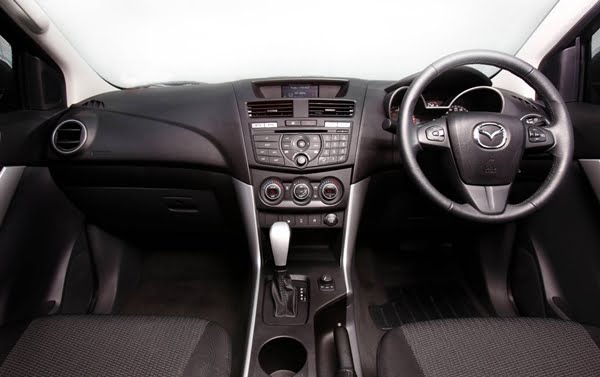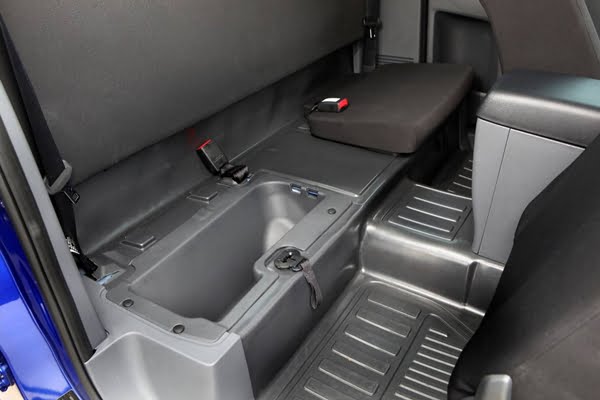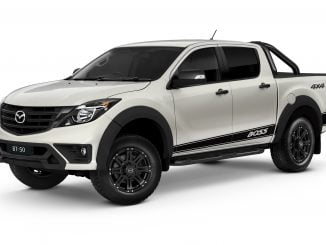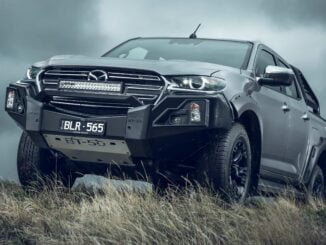When you’re looking for a workhorse you don’t really think of Mazda. You know they are there but you don’t really take them seriously when compared to the big 3. Now things are about to change with the release of the new BT-50.
When you first lay eyes on the new BT-50 you can tell it’s unmistakeably a Mazda with the Zoom-Zoom styling. This is an all new vehicle from the ground up and specifically tuned to suit Mazda. There is minimal sharing with its production line mate.
The new styling will definitely cause a stir amongst the more staid looking competitors, looking more car like and this continues through to the handling. Mazda has spent a lot of time re-engineering the front end of the BT-50 to suit their Zoom-Zoom philosophy and they’ve done a good job.
On our test route we took in most of the terrain your average Joe would go through. On the highway leg the BT-50 flew along with barely a murmur apart from a small amount of engine noise and some wind noise. The new engine and transmission mate perfectly and there is plenty of power to move you along up hill and down dale with minimal gear changes. The off-road section was designed to showcase its credentials and again the BT-50 did well, climbing, descending, traversing, wading and manoeuvring through some surprisingly tight turns thanks to the new front end geometry. The bit that really impressed me though was the back roads that incorporated gravel and corrugations. This is where all utes come unstuck with the ass end rattling all over the road and booming in the cabin. Mazda have done an excellent job with the suspension tuning and a nifty hydraulic body mount on the rear of the cabin eliminating the booming and noise transmission.
There are two new transmissions available, both being six speed. The manual and auto continue the Zoom-Zoom philosophy, the manual with its short sharp shift pattern and the auto with its positive selections.
Inside the Mazda is again very car like and comfortable. The seating is good with more room for rear occupants then the previous model.
There are plenty of nooks and crannies to hold all your gear and the glove box has been redesigned to hold a laptop.
From first impressions I am very impressed with the new BT-50 and think it has the potential to become a dominating force in the dual cab market. There are heaps of genuine accessories available and they look good. It has lots of off-road credential with all 4X4s coming standard with rear diff lock and the handling and safety to back it up. They also have some awesome looking packages with the Boss Adventure (steel) and Sports (alloy) Kits.
Let’s take a quick look at some of the features and figures of the BT-50
MZ-CD 3.2 I5
The new 3.2-litre diesel engine has an inline 5-cylinder configuration (a first for Mazda) with 20 valves, a turbocharger with an intercooler, and the latest common-rail direct injection technologies. It has a bore of 89.9mm and a stroke of 100.7mm for a displacement of 3,196cc. It gives class-leading maximum power of 147kW at 3,000rpm and class-leading maximum torque of 470Nm at 1,750– 2,500rpm (EEC).
.6-Speed Automatic Transmission
The new 6-speed automatic transmission replaces the current five-speed automatic transmission and is
available on certain models specified with the MZ-CD 3.2 I5 engine. Closely spaced gear ratios with a wide spread give excellent torque from low engine speeds while helping to realize low emissions and improved fuel efficiency.
The transmission has its own control unit, which allows high-speed gearshift control while communicating with the engine control module to enable smooth, precise shifting and excellent response to the driver’s demands. The AAS uses variables such as acceleration and deceleration rates, brake and throttle use, and cornering speeds to ensure that the vehicle is always in the right gear at the right time without undesired gearshifts. On downhill roads, the AAS automatically downshifts to generate additional braking from the powertrain when it senses that the driver is
applying the brakes. It thereby promotes downhill safety.
The 6-speed automatic transmission also has Sequential Shift Control (SSC), which offers Normal and
Performance modes plus a Manual mode that allows sequential manual shifting.
The torque converter has hydraulic slip lockup control, which is optimized for refinement and fuel
efficiency.
Gear ratios
1st 4.171
2nd 2.342
3rd 1.521
4th 1.143
5th 0.867
6th 0.691
Reverse 3.403
Final drive ratio 3.730
6-Speed Manual Transmission
The new 6-speed manual transmission has a short, car-type shift lever that’s optimally positioned for the driver, so it offers crisp, precise shifting that’s well matched to the generous torque of the new diesel engines.
Four-Wheel Drive (4WD) system
All three body types of the new Mazda BT-50 are available with a 4WD system for greater rough-road mobility. Every 4WD Mazda BT-50 (regardless of whether its transmission is automatic or manual) has an electronically controlled, shift-on-the-fly transfer case that allows the driver to shift between 2WD and 4WD at any time using a switch conveniently located on the floor console. The driver can shift between 2H and 4H with the vehicle moving at speeds up to 120km/h and the accelerator pedal released. For shifting between 4H and 4L, the driver must stop the vehicle and press the clutch pedal (with a manual transmission) or place the shift lever in the neutral position (with an automatic transmission). An electric locking rear differential is standard on all 4×4 versions.
Suspension
The all-new BT-50 has newly developed double-wishbone suspension at the front. Coil springs give
more linear response than the current BT-50’s torsion-bar spring. The stabilizer control link is attached to the axle rather than to the lower arms (as it is on the outgoing BT-50); a higher lever ratio makes the stabilizer more effective for better roll stiffness. Newly optimized front-suspension geometry suppresses disturbances from the road surface. And the lower-arm bushings are made of high-damping rubber, which limits steering shimmy and promotes ride comfort.
The leaf springs on the new BT-50 are 1,330mm long (10mm longer than those on the outgoing BT-50).
The extra length promotes ride comfort. Also, the leaf-eye bushings at the front have a diameter of
55mm (15mm bigger than those on the outgoing model). “the new BT-50 has rack-and pinion steering (the type of steering widely used on passenger cars)”
Although the new BT-50 has longer wheelbases than its predecessor (235mm longer with 2WD vehicles and 220mm longer with 4WD vehicles), increased maximum steering angles yield smaller turning circles (11.8m with 2WD vehicles and 12.4m with 4WD vehicles and 2WD Hi-Rider vehicles).
Braking
Like the outgoing BT-50, the new BT-50 has ventilated disc brakes at the front and drum brakes at the rear. The diameter of the front brake discs has been increased from 14 inches to 16 inches on all vehicles. And the single-piston callipers on 2WD vehicles have been replaced with the twin-piston callipers that feature on all 4WD models.
Body Types
Dual Cab (in both utility and cab-chassis)
Freestyle Cab (in both utility and cab-chassis)
Single Cab (in cab-chassis)
Audio System
Every vehicle in the new Mazda BT-50 line-up has an AM/FM radio, an MP3-capable CD player, and an AUX socket as standard equipment. All models have a modular system, which works with a multi function display situated in an easy-to-see position near the top of the centre stack. The display is a 3.5-inch monochrome super-twisted nematic (STN) display for XT models and a 5-inch colour liquid crystal display (LCD) with Satellite Navigation for XTR and GT models.
Tub
With every cab type, the floor width of the cargo box has been increased by 104mm and the height of the cargo box by 48mm. The floor length of the cargo box by has been increased by 19–94mm depending on cab type. As a result, the maximum cargo volume has been increased by 178 litres to 1,214 litres with the Dual Cab and by 226 litres to 1,453 litres with the Freestyle Cab.
Towing Capacity
Models powered by the MZ-CD 3.2 engine can tow up to a maximum of 3,350kg and those powered by the 2.2 litre engine have a maximum towing capacity of 2,500kg. Both have 10% maximum allowable ball weight of 335kg and 250kg respectively.
Vehicle Control Technologies
Antilock Braking System (ABS) with Electronic Brake-force Distribution (EBD)
Traction Control System (TCS)
Dynamic Stability Control (DSC)
Emergency Brake Assist (EBA)
Brake Override System (BOS)
Load Adaptive Control (LAC)
Trailer Sway Control (TSC)
Roll Stability Control (RSC)
Hill Launch Assist (HLA)
Hill Descent Control (HDC) (4×4 models only)
And the list goes on. Check out www.mazda.com.au for more details.
All-New Mazda BT-50 Dual Cab pricing –
There are three Freestyle Cab models in the new BT-50 range starting with the 4×2 Freestyle Cab Chassis XT at $32,590 and going through to the 4×4 Freestyle Cab Utility XTR at $46,810.
Dual Cab action kicks off with the 4×2 Dual Cab Utility XT at $36,090 and peaks with the leather appointed 4×4 Dual Cab Utility GT at $52,710.
Pricing of All-New BT-50 Freestyle and Dual Cab models is as follows:
Manufacturer’s List Price (MLP)
XT 4×2 Freestyle Cab Chassis 6MT $32,590
XT 4×2 Dual Cab Utility 6MT $36,090
XT 4×2 Dual Cab Utility 6AT $38,090
XTR 4×2 Dual Cab Utility 6MT $40,740
XTR 4×2 Dual Cab Utility 6AT $42,740
XT 4×4 Freestyle Cab Chassis 6MT $40,660
XTR 4×4 Freestyle Cab Utility 6MT $46,810
XT 4×4 Dual Cab Chassis 6MT $42,660
XT 4×4 Dual Cab Utility 6MT $44,160
XT 4×4 Dual Cab Utility 6AT $46,160
XTR 4×4 Dual Cab Utility 6MT $48,810
XTR 4×4 Dual Cab Utility 6AT $50,810
GT 4×4 Dual Cab Utility 6MT $50,710
GT 4×4 Dual Cab Utility 6AT $52,710

